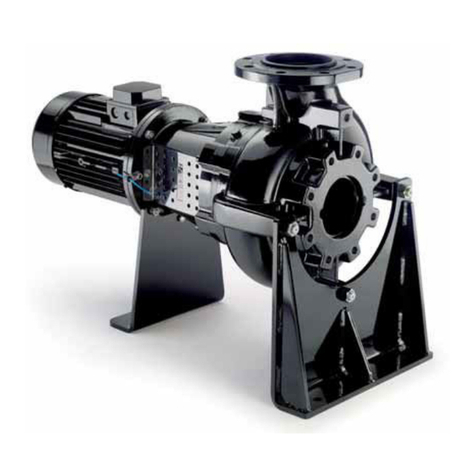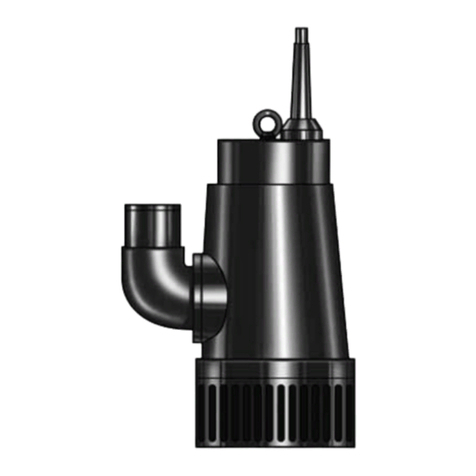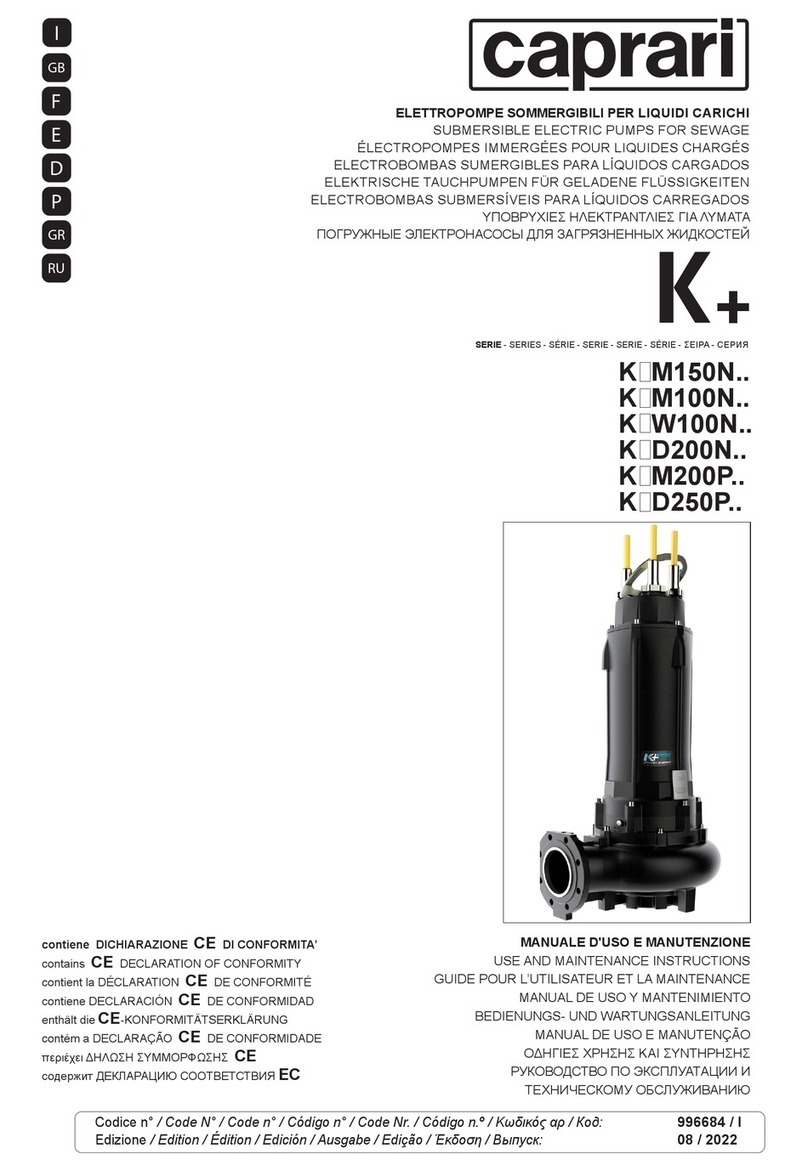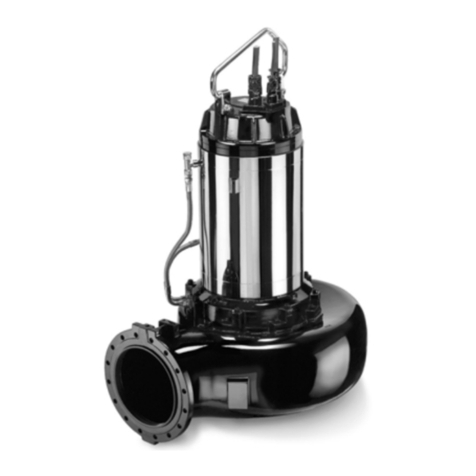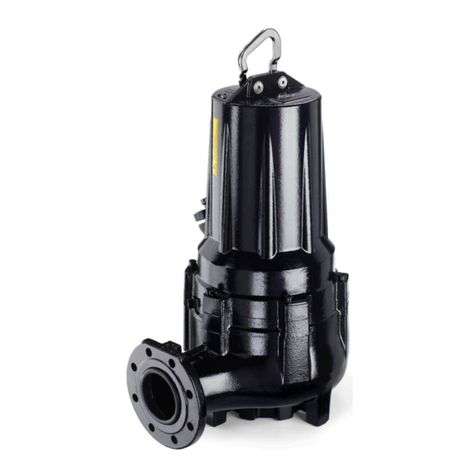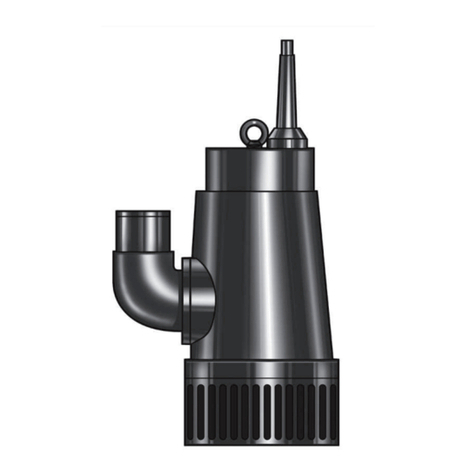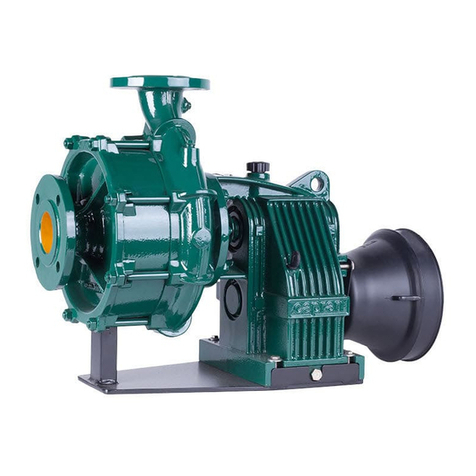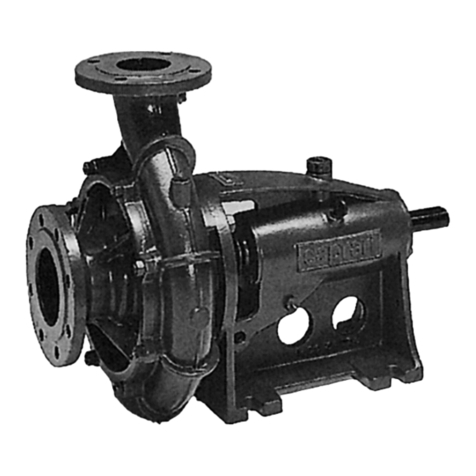
8
Caprari S.p.A.
D - M / DS - MS
I
Serie DX-MX/DSX-MSX
Controllo olio, idraulica e tenuta meccanica:
1) adagiare l’elettropompa su un fianco;
2) rimuovere le viti inferiori di chiusura dell’idraulica poste a fianco dell’aspirazione;
3) togliere l’eventuale succheruola e lo scudo inferiore;
4) rimuovere la vite di bloccaggio girante e la girante stessa;
5) pulire l’elettropompa da eventuali impurità nella zona della vite di carico-scarico olio posta dietro la girante;
6) sospendere l’elettropompa con un mezzo di sollevamento e rimuovere la vite di carico-scarico;
7) versare l’olio in un recipiente pulito e controllarlo relativamente alla qualità (presenza di impurità, tracce di acqua) ed alla quantità (consultare il
capitolo ‘Dimensione pesi e dati tecnici’);
8) adagiare l’elettropompa su un fianco;
9) se le condizioni dell’olio non sono ottimali, controllare lo stato della tenuta meccanica e se necessario sostituirla;
10) introdurre l’olio nella giusta quantità e qualità, utilizzando se ottimale quello estratto precedentemente (consultare ‘Tabella olio’ al capitolo ‘Dimensione
pesi e dati tecnici’);
11) rimontare l’elettropompa seguendo a ritroso la procedura di smontaggio, sostituendo le parti idrauliche se usurate.
Serie DA-MA/DSA-MSA
Controllo olio:
1) pulire l’elettropompa da eventuali impurità nella zona della vite di carico-scarico olio posta lateralmente all’idraulica;
2) adagiare l’elettropompa su un fianco e rimuovere la vite di carico-scarico;
3) versare l’olio in un recipiente pulito e controllarlo relativamente alla qualità (presenza di impurità, tracce di acqua) ed alla quantità (consultare la
‘Tabella olio’ al capitolo ‘Dimensione pesi e dati tecnici’);
4) se le condizioni dell’olio non sono ottimali, controllare lo stato della tenuta meccanica e ad anello, seguendo la procedura relativa, diversamente re
introdurre l’olio e rimontare la vite di carico e scarico.Controllo idraulica, tenuta meccanica e a labbro:
1) Estratrarre l’olio secondo la procedura ‘Controllo olio’;
2) rimuovere le viti inferiori di chiusura dell’idraulica poste a fianco dell’aspirazione;
3) togliere l’eventuale succheruola e lo scudo inferiore;
4) rimuovere la vite di bloccaggio girante e la girante stessa;
5) se l’elettropompa è a due stadi, procedere in successione allo smontaggio di tutta l’idraulica;
6) togliere gli anelli elastici, la tenuta a labbro e quella meccanica, controllarne lo stato e se necessario sostituirle;
7) rimontare l’elettropompa seguendo a ritroso la procedura di smontaggio, sostituendo le parti idrauliche se usurate e gli anelli di tenuta se non più
efficienti;
8) introdurre l’olio nella giusta quantità e qualità (consultare il capitolo ‘Dimensione pesi e dati tecnici’), e rimontare la vite di carico-scarico.
Serie MAT
Controllo delle parti soggette ad usura; per regolare il dispositivo di triturazione è necessario agire sui grani e sulle viti di bloccaggio al fine di registrare
girante e scudo di usura (luce di 0,2 ÷ 0,25mm).
Serie DR/DSR
Controllo olio ed infiltrazione liquido nel motore:
1) pulire l’elettropompa da eventuali impurità nella zona delle tre viti d’ispezione poste lateralmente all’idraulica (quella superiore di ispezione motore,
quella intermedia e quella inferiore di carico e scarico olio);
2) rimuovere la vite di ispezione motore;
3) se fuoriescono tracce di liquido controllare lo stato della tenuta meccanica lato pompa seguendo la procedura relativa;
4) adagiare l’elettropompa su un fianco e rimuovere le due viti di carico e scarico olio;
5) versare l’olio in un recipiente pulito e controllarlo relativamente alla qualità (presenza di impurità, tracce di acqua) ed alla quantità (consultare la
‘Tabella olio’ al capitolo ‘Dimensione pesi e dati tecnici’);
6) se le condizioni dell’olio sono ottimali introdurlo nuovamente e rimontare le viti di carico e scarico, altrimenti controllare lo stato della tenuta meccani
ca lato pompa seguendo la procedura relativa.
Controllo tenuta meccanica lato pompa:
1) Estrarre l’olio secondo la procedura ‘Controllo olio ed infiltrazione liquido nel motore’;
2) rimuovere i dadi di chiusura dell’idraulica poste lateralmente subito sopra alla succheruola;
3) togliere la succheruola e lo scudo inferiore;
4) rimuovere la vite di bloccaggio girante e la girante stessa;
5) togliere la tenuta meccanica, controllarne lo stato e se necessario sostituirla;
6) controllare la parte idraulica dell’elettropompa, se usurata seguire la procedura relativa;
7) rimontare l’elettropompa seguendo a ritroso la procedura di smontaggio;
8) introdurre l’olio nella giusta quantità e qualità (consultare il capitolo ‘Dimensione pesi e dati tecnici’).
Controllo idraulica:
1) adagiare l’elettropompa su un fianco;
2) rimuovere le viti di chiusura dell’idraulica poste lateralmente subito sopra alla succheruola;
3) togliere la succheruola e lo scudo inferiore;
4) se la girante è usurata, rimuovere la vite di bloccaggio e sostituirla;
5) se lo scudo inferiore è usurato sostituirlo;
6) rimontare lo scudo inferiore;
7) se necessario registrarlo agendo sulla serie di dadi e controdadi presenti attorno alla bocca di aspirazione in modo da accostarlo alla girante
verificando che questa resti libera di ruotare;
8) rimontare la succheruola.
6.4 Non utilizzo:
Consultare il capitolo ‘Immagazzinaggio e movimentazione.
7 MESSA FUORI SERVIZIO E SMANTELLAMENTO:
Nella fase di smantellamento del prodotto, l’operatore deve eseguire le fasi di messa fuori servizio e di distruzione attenendosi scrupolosamente al
rispetto delle norme e dei regolamenti di smaltimento locali.
Smaltimentodelprodottoanevita.
INFORMAZIONE AGLI UTILIZZATORI ai sensi dell’art. 14 della DIRETTIVA 2012/19/UE DEL PARLAMENTO EUROPEO E DEL CONSIGLIO del 4
luglio 2012 sui rifiuti di apparecchiature elettriche ed elettroniche (RAEE)
Il simbolo del cassonetto barrato riportato sull’apparecchiatura elettrica o/e elettronica (AEE) o sulla sua confezione indica che il
prodotto alla fine della propria vita utile deve essere raccolto separatamente e non smaltito assieme agli altri rifiuti urbani misti.
AEE DOMESTICHE
Si prega di contattare il proprio comune, o autorità locale, per tutte le informazioni inerenti i sistemi di raccolta separata disponibili nel
territorio. Il rivenditore della nuova apparecchiatura è obbligato al ritiro gratuito della vecchia, al momento dell’acquisto di una apparecchiatura di
tipo equivalente, ai fini dell’avvio del corretto riciclo/smaltimento. In Italia le AEE domestiche sono le elettropompe con motore monofase, nelle altre
nazioni europee occorre verificare tale classificazione.
AEE PROFESSIONALI
La raccolta differenziata della presente apparecchiatura giunta a fine vita è organizzata e gestita dal produttore. L’utente che vorrà disfarsi della
presente apparecchiatura potrà quindi contattare il produttore e seguire il sistema che questo ha adottato per consentire la raccolta separata
dell'apparecchiatura giunta a fine vita, oppure selezionare autonomamente una filiera autorizzata alla gestione. L’utente dovrà, in ogni caso,
rispettare le condizioni di ritiro poste dalla Direttiva 2012/19/UE.
Lo smaltimento abusivo del prodotto da parte dell’utente comporta l’applicazione delle sanzioni previste dalla legge.
8 GARANZIA:
Per il gruppo elettropompa in oggetto valgono le stesse condizioni generali di vendita di tutti i prodotti della caprari S.p.A.
In particolare si rammenta che una delle condizioni indispensabili al fine di ottenere l’eventuale riconoscimento della garanzia è il rispetto di tutte le
singole voci riportate nella documentazione allegata e delle migliori norme idrauliche ed elettrotecniche, condizione basilare per ottenere un
funziona
mento regolare del prodotto. Una disfunzione causata da logoramento e/o corrosione non è coperta da garanzia. Inoltre per il riconoscimento della
garanzia, è necessario che il prodotto venga preliminarmente esaminato dai nostri tecnici o da tecnici dei centri di assistenza autorizzata.
Il non rispetto di quanto riportato nella documentazione del prodotto, fa decadere ogni forma di garanzia e responsabilità.
